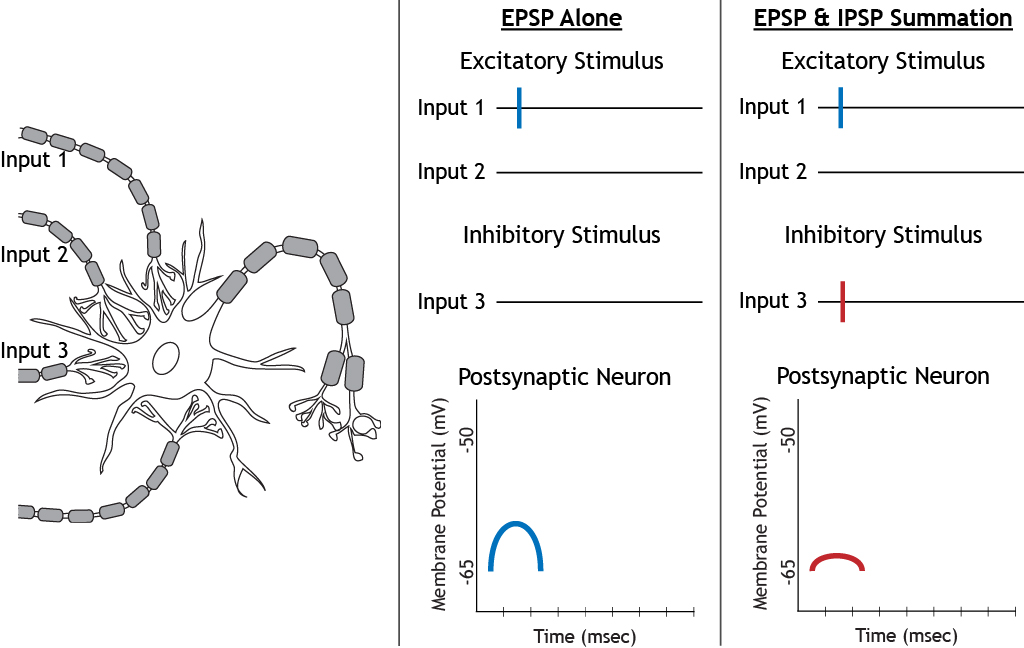Epsps Excitatory Postsynaptic Potentials Occur When
PSPs are called excitatory or EPSPs. The ________ channels open or close in response to physical distortion of the membrane surface.
Voltage-gated sodium channels have both an activation gate and a n ________ gate.

. A postsynaptic neuron will have an Excitatory Postsynaptic Potential EPSP when more potassium ions than usual diffuse out of the neuron. When two excitatory postsynaptic potentials EPSPs occur at a single synapse so rapidly in succession that the postsynaptic neurons membrane potential has not returned to the resting potential before the second EPSP arrives the EPSPs add together. These can be characterized directly under conditions when the postsynaptic membrane region of the muscle is voltage-clamped at a negative potential and the presynaptic nerve is stimulated Fig.
This temporary depolarization of postsynaptic membrane potential caused by the flow of positively charged ions into the postsynaptic cell is a result of opening ligand-gated ion channels. D chloride ions enter a cell. When two excitatory postsynaptic potentials EPSPs occur at a single synapse so rapidly in succession that the postsynaptic neuron s membrane potential has not returned to the resting potential before the second EPSP arrives the EPSPs add together producing _ _____.
- B sodium channels are opened causing depolarization C more potassium ions than usual leak out of a cell. EPSPs excitatory postsynaptic potentials occur when. Action potentials require the opening of voltage-gated channels.
After an Action Potential has traveled down an axon a neurotransmitter gets released affecting whether that postsynaptic cell is. More calcium ions than usual diffuse into the neuron. In neuroscience an excitatory postsynaptic potential EPSP is a temporary depolarization of postsynaptic membrane potential caused by the flow of positively charged ions into the postsynaptic cell.
B more potassium ions than usual leak out of a cell. Extra sodium ions enter a cell. By Jan 31 2021 Uncategorized.
47 When a second EPSP excitatory postsynaptic potential arrives at a single synapse before the effects of the first have. EPSPs excitatory postsynaptic potentials occur when. C extra sodium ions enter a cell.
EPSPs result from ionic excitatory postsynaptic currents EPSCs across the postsynaptic region of the muscle membrane taking place through opened AChRs. This positive increase in voltage above the normal resting neuronal potentialthat is to a less negative valueis called the excitatory postsynaptic potential EPSP because if this potential rises high enough in the positive direction it will elicit an action potential in the postsynaptic neuron thus exciting it. They are the opposite of inhibitory postsynaptic potentials IPSPs which usually result from the flow of negative ions into the cell.
In neuroscience an excitatory postsynaptic potential is a postsynaptic potential that makes the postsynaptic neuron more likely to fire an action potential. Graded potentials occur along dendrites whereas action potentials occur along axons. IPSPs inhibitory postsynaptic potentials are local hyperpolarizations.
Chemically-regulated potassium channels are open and potassium is diffusing out of the cell. B more calcium ions than usual leak out of a cell C chloride ions enter a cell. The site in the neuron where EPSPs and IPSPs are integrated is the.
46 EPSPs excitatory postsynaptic potentials occur when A more potassium ions than usual leak out of a cell. PSPs are called excitatory or EPSPs if they increase the likelihood of a postsynaptic action potential occurring and inhibitory or IPSPs if they decrease this likelihood. When two excitatory postsynaptic potentials EPSPs occur at a single synapse so rapidly in succession that the postsynaptic neurons membrane potential has not returned to the resting potential before the second EPSP arrives the EPSPs add together producing.
Given that most neurons receive inputs from both excitatory and inhibitory synapses it is important to understand more precisely the mechanisms that determine whether a particular synapse excites or inhibits. Occurs when more negatively charged ions are added to an already negatively charged receptor cell. The neuron is hyperpolarized.
When two excitatory postsynaptic potentials EPSPs occur at a single synapse so rapidly in succession that the postsynaptic neurons membrane potential has not returned to the resting potential before the second EPSP arrives the EPSPs add together. 1 EPSPs excitatory postsynaptic potentials occur when A hyperpolarizations occur. 1All of the above are true of EPSPs explanation.
D more calcium ions than. To evoke excitatory postsynaptic potentials EPSPs a monopolar electrode was placed in the stratum radiatum and 02 ms pulses were delivered using an ISO-Flex stimulator AMPI. An excitatory postsynaptic potentials EPSP is a temporary depolarization of postsynaptic membrane caused by the flow of positively charged ions into the postsynaptic cell as a result o View the full answer.
When two excitatory postsynaptic potentials EPSPs occur at a single synapse so rapidly in succession that the postsynaptic neurons membrane potential has not returned to the resting potential before the second EPSP arrives the EPSPs add together. 12 EPSPs excitatory postsynaptic potentials occur when A more calcium ions than usual leak out of a cell. Graded potentials that lead to action potentials are called synaptic potentials ie post-synaptic potential changes in neurons.
D extra sodium ions enter a cell E hyperpolarizations occur. Extra sodium ions enter a cell. These are the opposite of.

Postsynaptic Potentials Foundations Of Neuroscience

Mechanisms Of Excitatory Postsynaptic Potentials And Inhibitory Postsynaptic Potentials Neurons Sensory Integration Human Anatomy And Physiology

Pin By Glenn Kageyama On Anatomy Spatial Neuroscience Neurons

No comments for "Epsps Excitatory Postsynaptic Potentials Occur When"
Post a Comment